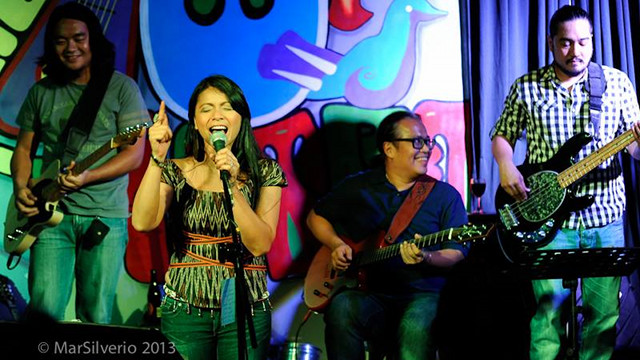SUMMARY
This is AI generated summarization, which may have errors. For context, always refer to the full article.

MANILA, Philippines — If her discography is any indication, Filipina singer-songwriter Bayang Barrios is a glass-half-full kind of artist.
Despite the fact that lowest-common-denominator pop and gimmicky vocalization are easy tickets to music-biz fame and fortune, Barrios, an Agusan del Sur-born Manobo turned longtime Quezon City resident, persists in being true to her music roots, true to her penchant for organic rhythm and melody — true to herself.
This is all made clear, once again, by her latest album, the just-out “Malaya.” This 12-track collection of new recordings is readily identical to her earlier projects — “Bayang Makulay” (1997), “Harinawa” (2001), “Alon” (2004) and “Biyaya” (2008).
“Malaya” is her first under Mayumi Records, the indie label named after her daughter with collaborator-husband Mike Villegas. (Mayumi’s hand paintings also adorn “Malaya’s” colorful packaging.)
Just as with her other records, “Malaya” finds Barrios singing lead vocals throughout, co-writing several of the tunes and providing some instrumental accompaniment. The lyrics, for their part, tackle circle-of-life realities, channeling musings and sentiments through the apt mood or pace, and at times verging on lofty yet penetrable poetry.

“Malaya” is different, however, in that, aside from songs by Barrios, Villegas or frequent co-producer/co-writer Sammy Asuncion, this 2013 album contains renditions of gems by some of Barrios’ lifelong idols and early music-making cohorts. Sweetening the arrangement is that some of these musicians even played on the new recordings, incidentally underscoring the album’s meaningful title: that, free from record-label restrictions, these independent artists can jam with each other anytime.
Foremost of these idols is Joey Ayala, he who got the proverbial ball rolling for Barrios upon recruiting her for his ’80s band Joey Ayala at ang Bagong Lumad. Three of Ayala’s previously recorded Bagong Lumad tunes — “Bata Batuta” off their album “Panganay ng Umaga,” and “Bathala” and “Awit ng Mortal” from “Mga Awit ng Tanod Lupa” — are part of “Malaya’s” repertoire. The singer-songwriter has his contemplative guitar-plucking do the singing here, alongside Barrios’ soaring voice.
Another is Gary Granada, whose “Iisa” is now a duet with his “Pag Nananalo ang Ginebra” renderer. A virtual guest can be felt via “Malaya’s” lead single, “Gising Na, Kaibigan,” a 1978 original by Asin authored by the folk quartet’s female vocalist Lolita Carbon. (Carbon has now teamed up with Barrios and Color It Red frontgal Cooky Chua for a new vocal venture, Tres Marias Pilipinas.)
Bassist-vocalist Onie Badiang, Barrios’ fellow Bagong Lumad alumnus, shared his composition “Adto na Kita” and wrote the music to “Ulan, Init” — even arranging and playing lead and bass guitar for the latter track. And there’s singer-songwriter Popong Landero, whose ditty “Malaya” wound up as Barrios’ latest title track.

That said, “Malaya” is far from a typical covers-loaded album.
Be they original material by Barrios, Villegas and Asuncion or the previously released contents, the tunes have been fashioned by Barrios and crew — who also include guitarist-arrangers Kakoy Legaspi and Angelo Villegas — in such a way that it’s as if they’re the 45-year-old singer’s own.
And not only is “Malaya” an outlet for Barrios’ alto evoking Nora Aunor, the album comes off as a showcase of the composers’ respective lyrical and musical styles — even if Barrios and friends manage to weave everything into a unified-sounding whole.
Its cohesion aside, “Malaya” is far from devoid of diversity.

“Gising Na, Kaibigan” is a gentle rouser, Carbon’s signature inflections still apparent in Barrios’ non-raspy voice. The song calls for a full-on awakening, nicely bookended by the entire album’s lone set of keyboard lines. “Iisa” is “Malaya” at its most pop-sounding, as Barrios and Granada sing about how love can turn two people into a one profound whole.
The 3 Ayala tracks are compelling contradictions: gentle as their music is (played and arranged by Ayala himself), their lyrics are thought-provoking essays about acknowledging a higher being and our mortality, eschewing opportunism and celebrating resilience despite life’s countless curveballs.
Barrios’ two compositions with bluesy guitarist Sammy Asuncion are curious polar opposites. “Makakabangon Din” is an uptight, percussive espousal of firm resolve, with Barrios’ vocal taking flight as if to stress that point. “Pahinga Muna” is a breather of a ballad aimed at inciting not just physical but psychical rest, made sonorous and haunting by violin and cello layers.

The Badiang-cowritten “Ulan, Init” and -written “Adto na Kita,” for their part, find Malaya at its most playful — “Ulan” alluding to the comforting realization that the weather’s, and life’s, fickleness can be a favorable reality, while “Adto Na Kita” (which roughly translates as “Let’ Go There”) is a rolling track that somehow mimics the natural high of being in the zone.
“Naghahari,” the album’s uniquely reggae entry, is Villegas’ way of adding to “Malaya’s” sunny quotient, its lighthearted tone extending to the lyrics’ be-good-to-yourself advice to a hapless romantic. “Ipagbunyi sa Mundo,” the only track composed by Barrios alone, is a pep tune in behalf of Filipino music — its rah-rah spirit emanating from a festive fusion of basic pop-rock with ethnic accents (i.e., the kubing and the kulintang), implying that Pinoy artists of differing genres or inclinations need not be each other’s competitors.
At the core of all this is the title track. As Landero conceived it, “Malaya” is a thoughtful, ponderous reminder of the heavenly blessing of free will and how it is the human counterpart to a bird’s freedom to fly or a river’s freedom to flow.

Hardly the stuff of run-of-the-mill, low-brow albums, that. Yet “Malaya” is not at all a pretentious, exclusivist diversion. It is a populist, country-flavored oasis — a means to emancipate, if only for under 50 minutes, highly urbanized eardrums and sensibilities.
Its very significance and soundness may not yield for “Malaya” the thousands of ears that should give it a good listen. Yet Barrios would rather be free to be her spirited self, instead of being shackled by the confines of contrived, disposable pop.
It’s as if she’s heeding the conclusive rally of “Awit ng Mortal”: “Ang bukas na nais mong makita / Ngayon pa ma’y simulan mo na” (“The tomorrow you seek / Get it started today”). And for that, listeners all over should also feel free to thank her — for the gift of superlative Filipino music and for encouraging the rest of us to be true and free as well. – Rappler.com
‘Malaya’ is available at Astrovision stores and at Barrios’ shows. Her gigs this month include a Tres Marias Pilipinas stint at ‘Salinawit Night with Pete Lacaba’ at Conspiracy Bar on June 18; the NCCA’s 25th anniversary concert, June 26; “Aawitan Kita Live” at the University of Makati, June 28; and her ‘Malaya’ show at The ’70s Bistro, June 29. For further details, like the Bayang Barrios fan page on Facebook.
Add a comment
How does this make you feel?
There are no comments yet. Add your comment to start the conversation.